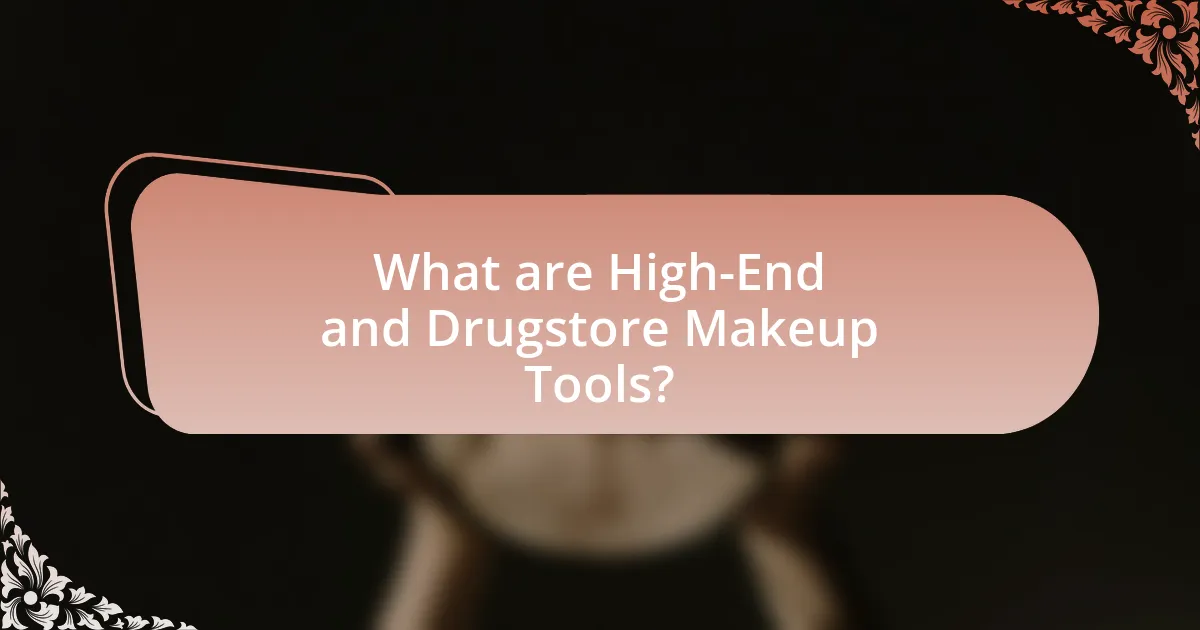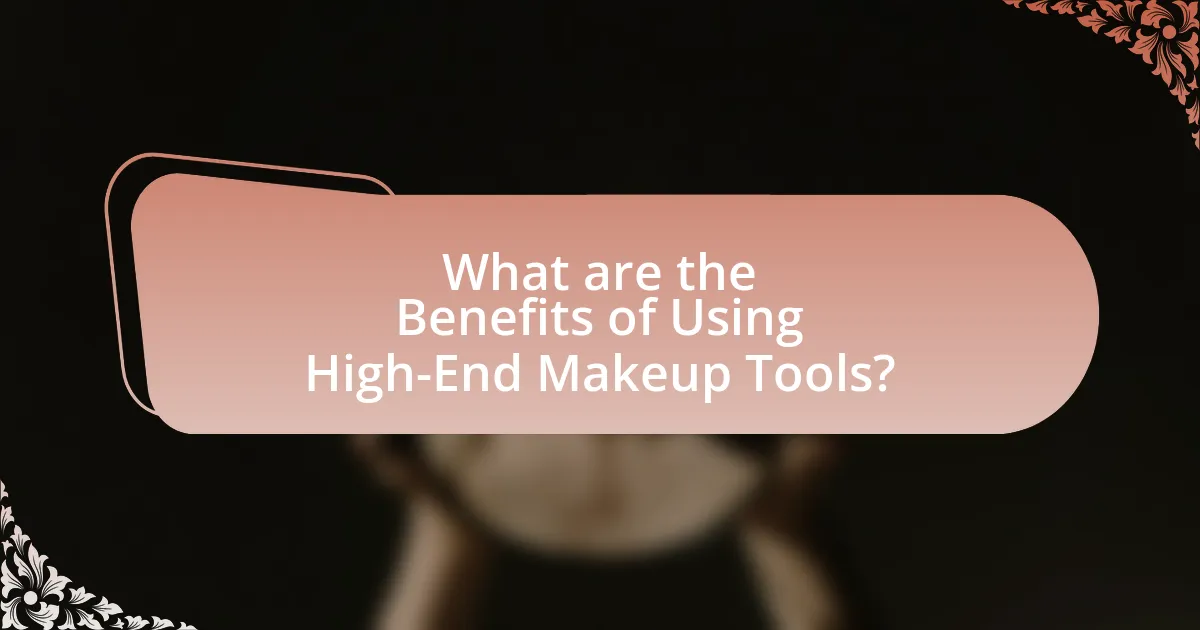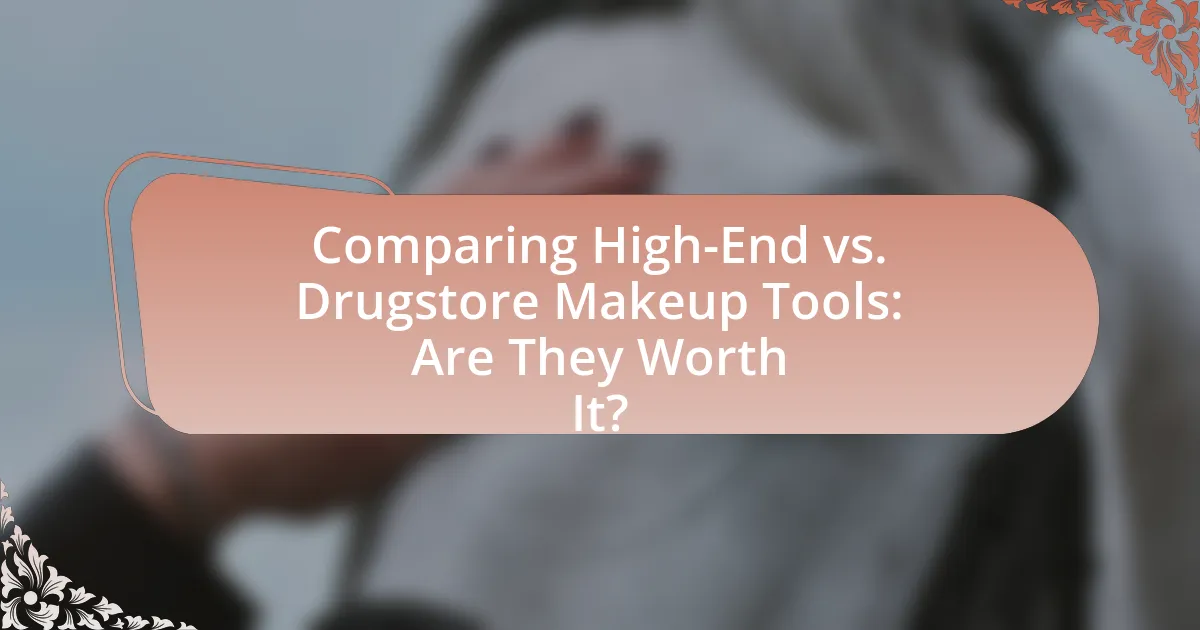The article focuses on comparing high-end and drugstore makeup tools, examining their differences in quality, materials, pricing, and user experience. High-end tools are characterized by superior materials and craftsmanship, resulting in enhanced performance and longevity, while drugstore tools offer affordability and accessibility for a broader audience. Key discussions include the materials used in both categories, the price ranges, the benefits and drawbacks of each type, and how consumers can make informed choices based on their specific needs and preferences. The article also highlights the effectiveness of budget-friendly alternatives and the potential limitations of drugstore options.

What are High-End and Drugstore Makeup Tools?
High-end makeup tools are professional-grade products typically made from superior materials, designed for durability and performance, often associated with luxury brands. In contrast, drugstore makeup tools are more affordable, widely available, and made from less expensive materials, catering to a broader audience. High-end tools often feature advanced technology and craftsmanship, which can enhance makeup application and longevity, while drugstore tools provide accessibility and practicality for everyday use. The distinction lies in quality, price, and intended user experience, with high-end tools often justifying their cost through enhanced performance and longevity.
How do High-End Makeup Tools differ from Drugstore Options?
High-end makeup tools differ from drugstore options primarily in quality, performance, and longevity. High-end tools are often made with superior materials, such as synthetic or natural hair that provides better application and blending capabilities, resulting in a more polished finish. For instance, brands like MAC and Sigma use high-grade fibers that enhance product pickup and distribution, while drugstore brands may use lower-quality materials that can lead to uneven application. Additionally, high-end tools typically undergo more rigorous quality control processes, ensuring consistency and durability, which can justify their higher price point. Studies indicate that professional makeup artists prefer high-end tools for their reliability and effectiveness, further supporting the distinction between these two categories.
What materials are commonly used in High-End Makeup Tools?
High-end makeup tools are commonly made from materials such as synthetic fibers, natural hair, metal, and high-quality plastics. Synthetic fibers, like Taklon, are favored for their durability and ease of cleaning, while natural hair, sourced from animals like sable or goat, is prized for its softness and ability to blend products seamlessly. Metal components, often used in brush ferrules and handles, provide strength and longevity, while high-quality plastics are utilized for their lightweight and ergonomic properties. These materials contribute to the overall performance and longevity of high-end makeup tools, making them a preferred choice among professional makeup artists and enthusiasts.
What materials are typically found in Drugstore Makeup Tools?
Drugstore makeup tools are typically made from materials such as plastic, synthetic fibers, and metal. Plastic is commonly used for handles and packaging due to its affordability and lightweight nature. Synthetic fibers, often made from nylon or polyester, are prevalent in brushes and sponges, providing a cost-effective alternative to natural hair while still offering decent performance. Metal components, such as ferrules and clasps, are used for durability and stability in various tools. These materials are chosen to balance cost, functionality, and accessibility for consumers.
What are the price ranges for High-End and Drugstore Makeup Tools?
High-end makeup tools typically range from $20 to over $100 per item, while drugstore makeup tools generally cost between $5 and $20. High-end brands often offer superior materials and craftsmanship, which justifies their higher price point. In contrast, drugstore options provide affordability and accessibility, catering to a wider audience without compromising basic functionality.
How does the pricing reflect the quality of the tools?
Pricing directly correlates with the quality of makeup tools, as higher-priced tools often utilize superior materials and craftsmanship. For instance, high-end brushes typically feature natural bristles that provide better application and longevity compared to synthetic bristles found in lower-priced options. Additionally, premium brands invest in research and development, resulting in innovative designs that enhance usability and performance. Studies indicate that consumers often report higher satisfaction and effectiveness with tools priced above a certain threshold, reinforcing the notion that price can be an indicator of quality in makeup tools.
Are there budget-friendly alternatives to High-End Makeup Tools?
Yes, there are budget-friendly alternatives to high-end makeup tools. Many drugstore brands offer quality makeup brushes, sponges, and applicators that perform comparably to their high-end counterparts. For instance, brands like Real Techniques and e.l.f. provide makeup brushes that are well-reviewed for their effectiveness and affordability, often costing a fraction of the price of high-end tools. Additionally, beauty retailers frequently carry sales and promotions, making it easier to find quality tools at lower prices.

What are the Benefits of Using High-End Makeup Tools?
High-end makeup tools offer superior quality, resulting in better application and finish compared to lower-end alternatives. These tools are often made from high-grade materials, such as synthetic or natural fibers, which enhance product performance and longevity. For instance, brushes made from high-quality bristles can blend makeup more seamlessly, leading to a more polished look. Additionally, high-end tools are designed ergonomically, providing comfort during use and reducing hand fatigue. Research indicates that professional makeup artists prefer high-end tools for their durability and effectiveness, which can lead to a more satisfying user experience and improved makeup results.
How do High-End Makeup Tools enhance makeup application?
High-end makeup tools enhance makeup application by providing superior precision, better product distribution, and improved blending capabilities. These tools are often made with high-quality materials, such as synthetic or natural bristles that are designed to pick up and apply product more effectively than lower-quality alternatives. For instance, a study published in the Journal of Cosmetic Science found that brushes with finer bristles can create a smoother finish and reduce the appearance of imperfections on the skin. Additionally, high-end tools often feature ergonomic designs that allow for greater control during application, resulting in a more polished look.
What specific features contribute to better performance?
High-end makeup tools typically feature superior materials, advanced technology, and ergonomic designs that contribute to better performance. For instance, high-end brushes often use high-quality synthetic or natural bristles that provide better product application and blending capabilities compared to drugstore alternatives. Additionally, features such as precision-engineered handles enhance grip and control, allowing for more accurate makeup application. Studies have shown that tools with these characteristics can significantly improve the overall finish and longevity of makeup, as evidenced by user satisfaction ratings that consistently favor high-end products for their effectiveness and ease of use.
How do High-End Tools affect the longevity of makeup?
High-end tools significantly enhance the longevity of makeup by providing superior application and blending capabilities. These tools, often made with high-quality materials, allow for a more even distribution of products, which helps prevent makeup from settling into fine lines or fading throughout the day. For instance, brushes made from natural fibers can hold and distribute product more effectively than synthetic alternatives, leading to a longer-lasting finish. Additionally, high-end tools often feature ergonomic designs that facilitate better control, resulting in a more precise application that can withstand wear over time.
What are the potential drawbacks of High-End Makeup Tools?
High-end makeup tools can be expensive, which may not justify their cost for all consumers. The high price point often leads to the perception that they offer superior quality, but this is not always the case, as some drugstore alternatives perform comparably. Additionally, high-end tools may require specific maintenance or care that can be cumbersome, such as special cleaning solutions or storage conditions. Furthermore, the marketing surrounding high-end products can create unrealistic expectations, leading to disappointment if the tools do not meet those standards. Lastly, the exclusivity of some high-end brands can limit accessibility for a broader audience, making it difficult for many consumers to invest in these products.
Are High-End Tools worth the investment for casual users?
High-end tools are generally not worth the investment for casual users. Casual users typically do not require the advanced features and superior quality that high-end tools offer, as their makeup application needs are often basic. Research indicates that many drugstore makeup tools perform comparably to high-end options for everyday use, providing satisfactory results without the significant financial commitment. For instance, a study published in the Journal of Cosmetic Science found that the performance of drugstore brushes was rated similarly to that of luxury brands by users with average makeup experience. Therefore, casual users can achieve desired results with more affordable options.
What maintenance is required for High-End Makeup Tools?
High-end makeup tools require regular cleaning, proper storage, and occasional replacement of worn components to maintain their performance and longevity. Cleaning should be done after each use with a gentle cleanser or brush cleaner to prevent product buildup and bacteria growth. Proper storage involves keeping tools in a dry, cool place, ideally in a protective case to avoid damage. Additionally, users should inspect tools periodically for signs of wear, such as frayed bristles or damaged handles, and replace them as necessary to ensure optimal application and hygiene.

What are the Benefits of Using Drugstore Makeup Tools?
Drugstore makeup tools offer affordability, accessibility, and a wide variety of options for consumers. These tools are typically priced lower than high-end alternatives, making them budget-friendly for a broader audience. Additionally, drugstore brands often provide a diverse range of products that cater to different skin types and preferences, allowing users to experiment without significant financial investment. Studies indicate that many drugstore makeup tools perform comparably to their high-end counterparts, providing effective results at a fraction of the cost. This combination of cost-effectiveness and variety makes drugstore makeup tools a practical choice for many consumers.
How do Drugstore Makeup Tools provide value for money?
Drugstore makeup tools provide value for money by offering quality performance at a significantly lower price compared to high-end alternatives. These tools often utilize similar materials and designs as their more expensive counterparts, ensuring effective application and durability. For instance, many drugstore brands have been recognized for their innovative designs and functionality, such as blending sponges and brushes that rival those from premium brands. Additionally, consumer reviews and beauty expert recommendations frequently highlight the effectiveness of drugstore tools, demonstrating that they can achieve comparable results without the financial burden. This combination of affordability and performance makes drugstore makeup tools a smart choice for budget-conscious consumers seeking quality in their beauty routines.
What features make Drugstore Tools appealing to consumers?
Drugstore tools appeal to consumers primarily due to their affordability, accessibility, and variety. These tools are typically priced lower than high-end alternatives, making them budget-friendly for a wider audience. Additionally, drugstore tools are readily available in numerous retail locations, allowing consumers to easily purchase them without the need for specialized stores. The variety offered includes a range of options suitable for different makeup applications, catering to diverse consumer preferences. According to a survey by Statista, 60% of consumers prioritize price when selecting beauty tools, highlighting the significance of affordability in their purchasing decisions.
How do Drugstore Tools cater to a wider audience?
Drugstore tools cater to a wider audience by offering affordable, accessible options that meet diverse consumer needs. These tools are typically priced lower than high-end alternatives, making them available to a broader demographic, including budget-conscious shoppers and beginners in makeup application. Additionally, drugstore brands often provide a variety of products that cater to different skin types, tones, and preferences, ensuring inclusivity. For instance, brands like e.l.f. and Wet n Wild have gained popularity for their extensive ranges that appeal to various consumers, evidenced by their significant market share in the beauty industry. This combination of affordability and variety allows drugstore tools to effectively reach and serve a larger audience.
What are the limitations of Drugstore Makeup Tools?
Drugstore makeup tools often have limitations in quality, durability, and performance compared to high-end alternatives. These tools may use lower-grade materials, which can affect their longevity and effectiveness, leading to issues such as shedding bristles in brushes or less precise application. Additionally, drugstore tools may not offer the same level of innovation or design features found in premium brands, resulting in a less enjoyable user experience. Studies indicate that while drugstore products can be cost-effective, they may not meet the professional standards required for high-quality makeup application, as evidenced by user reviews and expert comparisons in beauty publications.
How does the quality of Drugstore Tools compare to High-End options?
The quality of drugstore tools generally falls short compared to high-end options. High-end tools often utilize superior materials, such as high-grade synthetic fibers or natural hair, which enhance performance and durability. For instance, a study by the Journal of Cosmetic Science indicates that high-end brushes can provide better product application and blending due to their advanced design and construction. In contrast, drugstore tools may use lower-quality materials that can lead to uneven application and a shorter lifespan. Thus, while drugstore tools can be cost-effective, they typically do not match the quality and performance of high-end alternatives.
What common issues do users face with Drugstore Tools?
Users commonly face issues with drugstore tools such as inconsistent quality, durability concerns, and limited effectiveness compared to high-end alternatives. Inconsistent quality often leads to varying performance, where some tools may not function as intended, resulting in user frustration. Durability concerns arise from the materials used, which may not withstand regular use, leading to breakage or wear over time. Additionally, limited effectiveness can manifest in tools that do not deliver the desired results, such as uneven application or difficulty in achieving specific makeup looks. These issues highlight the challenges users encounter when opting for drugstore tools in their makeup routines.
How can consumers make informed choices between High-End and Drugstore Makeup Tools?
Consumers can make informed choices between high-end and drugstore makeup tools by evaluating factors such as quality, price, and specific needs. High-end tools often feature superior materials and craftsmanship, which can enhance application and durability, while drugstore tools provide affordability and accessibility. Research indicates that many drugstore options perform comparably to high-end brands, making them a viable choice for budget-conscious consumers. Additionally, reading reviews and testing products in-store can help consumers assess performance and suitability for their individual makeup routines.
What factors should be considered when selecting makeup tools?
When selecting makeup tools, factors such as material quality, intended use, and price point should be considered. High-quality materials, like synthetic or natural fibers, affect the tool’s performance and durability. The intended use, whether for foundation, eyeshadow, or contouring, determines the shape and size of the tool needed. Price point is also crucial; while high-end tools may offer superior performance, many drugstore options provide comparable quality at a lower cost, making them a viable choice for budget-conscious consumers.
How can users test the effectiveness of different tools before purchasing?
Users can test the effectiveness of different tools before purchasing by utilizing product samples, reading reviews, and visiting stores for hands-on trials. Product samples allow users to experience the tool’s performance firsthand, while reviews from credible sources provide insights into the experiences of other consumers. Additionally, many beauty retailers offer testers in-store, enabling users to assess the quality and suitability of the tools directly. According to a survey by Statista, 79% of consumers read reviews before making a purchase, highlighting the importance of informed decision-making based on collective user experiences.


